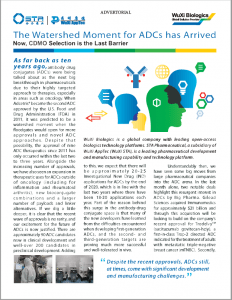 As far back as 10 years ago, antibody–drug conjugates (ADCs) were being talked about as the next big breakthrough in pharmaceuticals due to their highly targeted approach to therapies, especially in areas such as oncology. When Adcetris (brentuximab vedotin) became the second ADC approved by the US Food and Drug Administration (FDA) in 2011, it was predicted to be a watershed moment when the floodgates would open for more approvals and novel ADC approaches. Despite that possibility, the approval of nine ADC therapeutics since 2011 has occurred only within the last two years. Alongside the increasing number of approvals, we have also seen an expansion in therapeutic uses for ADCs outside of oncology (including for inflammation and rheumatoid arthritis), new bioconjugate combinations, and a larger number of payloads and linker alternatives.
As far back as 10 years ago, antibody–drug conjugates (ADCs) were being talked about as the next big breakthrough in pharmaceuticals due to their highly targeted approach to therapies, especially in areas such as oncology. When Adcetris (brentuximab vedotin) became the second ADC approved by the US Food and Drug Administration (FDA) in 2011, it was predicted to be a watershed moment when the floodgates would open for more approvals and novel ADC approaches. Despite that possibility, the approval of nine ADC therapeutics since 2011 has occurred only within the last two years. Alongside the increasing number of approvals, we have also seen an expansion in therapeutic uses for ADCs outside of oncology (including for inflammation and rheumatoid arthritis), new bioconjugate combinations, and a larger number of payloads and linker alternatives.
If we dig a little deeper, it is clear that the recent wave of approvals is no rarity, and our excitement for the future of ADC therapeutics is now justified. There are approximately 90 ADC candidates now in clinical development and well over 200 candidates in preclinical development. Adding to this, we expect that there will have been approximately 20 to 25 investigational new drug (IND) applications for ADCs by the end of 2020, which is in line with the last two years where there have been 18 to 20 applications each year.
Click the button to read the complete article and learn more about ADC therapeutics now.

